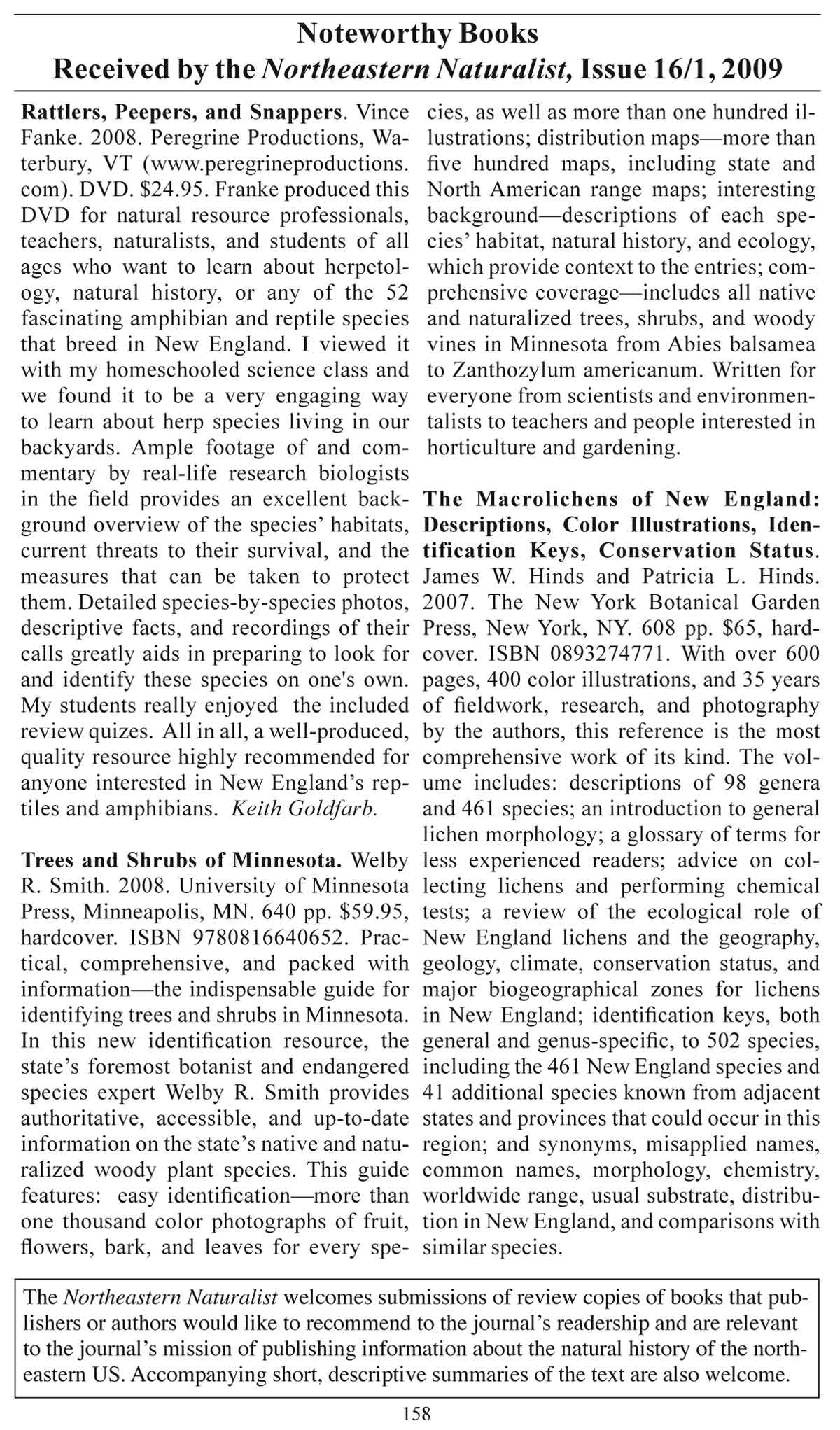Access Journal Content
Open access browsing of table of contents and abstract pages. Full text pdfs available for download for subscribers.
Current Issue: Vol. 30 (3)

Check out NENA's latest Monograph:
Monograph 22









Rattlers, Peepers, and Snappers. Vince
Fanke. 2008. Peregrine Productions, Waterbury,
VT (www.peregrineproductions.
com). DVD. $24.95. Franke produced this
DVD for natural resource professionals,
teachers, naturalists, and students of all
ages who want to learn about herpetology,
natural history, or any of the 52
fascinating amphibian and reptile species
that breed in New England. I viewed it
with my homeschooled science class and
we found it to be a very engaging way
to learn about herp species living in our
backyards. Ample footage of and commentary
by real-life research biologists
in the field provides an excellent background
overview of the species’ habitats,
current threats to their survival, and the
measures that can be taken to protect
them. Detailed species-by-species photos,
descriptive facts, and recordings of their
calls greatly aids in preparing to look for
and identify these species on one's own.
My students really enjoyed the included
review quizes. All in all, a well-produced,
quality resource highly recommended for
anyone interested in New England’s reptiles
and amphibians. Keith Goldfarb.
Trees and Shrubs of Minnesota. Welby
R. Smith. 2008. University of Minnesota
Press, Minneapolis, MN. 640 pp. $59.95,
hardcover. ISBN 9780816640652. Practical,
comprehensive, and packed with
information—the indispensable guide for
identifying trees and shrubs in Minnesota.
In this new identification resource, the
state’s foremost botanist and endangered
species expert Welby R. Smith provides
authoritative, accessible, and up-to-date
information on the state’s native and naturalized
woody plant species. This guide
features: easy identification—more than
one thousand color photographs of fruit,
flowers, bark, and leaves for every species,
as well as more than one hundred illustrations;
distribution maps—more than
five hundred maps, including state and
North American range maps; interesting
background—descriptions of each species’
habitat, natural history, and ecology,
which provide context to the entries; comprehensive
coverage—includes all native
and naturalized trees, shrubs, and woody
vines in Minnesota from Abies balsamea
to Zanthozylum americanum. Written for
everyone from scientists and environmentalists
to teachers and people interested in
horticulture and gardening.
The Macrolichens of New England:
Descriptions, Color Illustrations, Identification
Keys, Conservation Status.
James W. Hinds and Patricia L. Hinds.
2007. The New York Botanical Garden
Press, New York, NY. 608 pp. $65, hardcover.
ISBN 0893274771. With over 600
pages, 400 color illustrations, and 35 years
of fieldwork, research, and photography
by the authors, this reference is the most
comprehensive work of its kind. The volume
includes: descriptions of 98 genera
and 461 species; an introduction to general
lichen morphology; a glossary of terms for
less experienced readers; advice on collecting
lichens and performing chemical
tests; a review of the ecological role of
New England lichens and the geography,
geology, climate, conservation status, and
major biogeographical zones for lichens
in New England; identification keys, both
general and genus-specific, to 502 species,
including the 461 New England species and
41 additional species known from adjacent
states and provinces that could occur in this
region; and synonyms, misapplied names,
common names, morphology, chemistry,
worldwide range, usual substrate, distribution
in New England, and comparisons with
similar species.
Noteworthy Books
Received by the Northeastern Naturalist, Issue 16/1, 2009
The Northeastern Naturalist welcomes submissions of review copies of books that publishers
or authors would like to recommend to the journal’s readership and are relevant
to the journal’s mission of publishing information about the natural history of the northeastern
US. Accompanying short, descriptive summaries of the text are also welcome.












 The Northeastern Naturalist is a peer-reviewed journal that covers all aspects of natural history within northeastern North America. We welcome research articles, summary review papers, and observational notes.
The Northeastern Naturalist is a peer-reviewed journal that covers all aspects of natural history within northeastern North America. We welcome research articles, summary review papers, and observational notes.